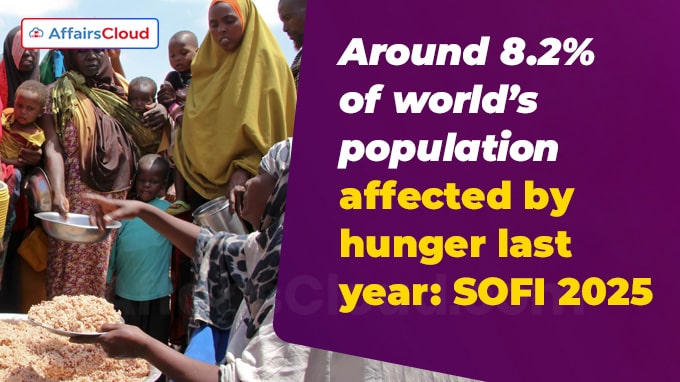 In July 2025, United Nations (UN) released its latest report titled ‘The State of Food Security and Nutrition in the World (SOFI 2025): Addressing high food price inflation for food security and nutrition’ during the 2nd UN Food Systems Summit Stocktake (UNFSS+4) in Addis Ababa, Ethiopia. As per the report, around 8.2% of world’s population (673 million individuals) was affected by hunger in 2024, compared to 8.5% (in 2023) and 8.7% (in 2022).
In July 2025, United Nations (UN) released its latest report titled ‘The State of Food Security and Nutrition in the World (SOFI 2025): Addressing high food price inflation for food security and nutrition’ during the 2nd UN Food Systems Summit Stocktake (UNFSS+4) in Addis Ababa, Ethiopia. As per the report, around 8.2% of world’s population (673 million individuals) was affected by hunger in 2024, compared to 8.5% (in 2023) and 8.7% (in 2022).
- However, the report noted that this progress was not consistent worldwide, as hunger continued to increase in most subregions of Africa and western Asia.
- The report also revealed that 18.7% or, over 21 million of Indian children under the age of 5 suffered from wasting in 2024, the highest rate in the world.
About SOFI Report:
Prepared by: It is an annual report prepared by 5 specialized agencies of United Nations (UN): Food and Agriculture Organisation (FAO), International Fund for Agricultural Development (IFAD), UN Children’s Fund (UNICEF), World Food Programme (WFP) and World Health Organisation (WHO).
Key Findings:
Undernourished People: Asia region accounted for the highest number of undernourished people at 323 million, followed by Africa (307 million) and Latin America and the Caribbean (34 million).
Global Hunger Higher than Pre-Pandemic Levels: The report noted that global prevalence of moderate or severe food insecurity has decreased marginally from 28.4% (in 2023) to 28% (2.3 billion people) in 2024, which was still 355 million higher than pre-COVID pandemic levels.
- This decrease was also 683 million more compared to 2015, when Sustainable Development Agenda was adopted by UN.
- The report further estimated that 96 million more people were suffering from chronic hunger in 2025 compared to 2015
Prevalence of Undernourishment (PoU): Asia region saw decrease in PoU from 7.9% (in 2022) to 6.7% or 32 million people (in 2024).
Key Indicators:
Obesity: As per the report, globally, obesity among children increased from 5.3% (in 2012) to 5.5% (in 2024).
- While, adult obesity increased from 12.1% (in 2012) to 15.8% (in 2022).
Child Wasting: The report showed that child wasting decreased from 7.4% (in 2012) to 6.6% (in 2024).
Breastfeeding: The rate of breastfeeding among infants under 6 months increased from 37% (in 2012) to 47.8% (in 2023).
Anaemia: The data of report showed the global prevalence of anaemia among women (aged 15 to 49), from 27.6% (in 2012) to 30.7% (in 2023).
Minimum Dietary Diversity: The report revealed that about 1/3rd (33%) of children aged 6 to 23 months and 2/3rd of women aged 15 to 49 years, met minimum dietary diversity.
Food Inflation:
Gap between Headline Inflation and Food Inflation: As per the report, the global food price inflation reached to 13.6% in January 2023 (up from average food inflation of 2.3% in 2020), 5.1 basis points (bps) higher than headline inflation rate of 8.5%.
Higher Food Inflation in LICs: The report revealed that global food price inflation peaked in Low-Income Countries (LICs) to 30% in May 2023.
India-Specific:
Child Stunting: The report showed that 37.4 million Indian children under the age of 5 were stunted in 2024.
Increase in Anaemia among Indian Women: As per the report, over 50% of Indian women (aged between 15-49 years) now suffer from anaemia, which has been steadily increasing from 50.1% (in 2012) to 53.7%, representing 203 million women in India (in 2023).
- The report further highlighted that globally, India ranked at 4th position in terms of highest rate of anaemia, only behind African nations i.e. Gabon, Mali and Mauritania.
Undernourished People: The report showed that over 172 million people in India were undernourished in 2024, much lower than 243 people in 2006.
- At global level, India ranked 48th out of 204 countries examined for undernourishment and 7th within Asia region.
Affordability of Healthy Diet: The report further revealed that 42.9% of India’s population could not afford a healthy diet.
- It also highlighted a steady increase in the cost of healthy diet in India, from USD 2.77 Purchasing Power Parity (PPP) per person per day (in 2017) to USD 4.07 (in 2024).
Obesity: As per the report, the number of overweight children under the age of 5 increased from 2.7 million (2012) to 4.2 million (2024).
- While, the adult obese population more than doubled in last 10 years, from 33.6 million to 71.4 million.
About Food and Agriculture Organisation (FAO):
Director-General (DG)- Qu Dongyu
Headquarters- Rome, Italy
Established- 1945




